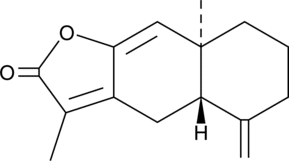Territorial Availability: Available through Bertin Technologies only in France
- Synonyms
- 4aS,5,6,7,8,8aS-hexahydro-3,8a-dimethyl-5-methylene-naphtho[2,3-b]furan-2(4H)-one
- Correlated keywords
- Atractylodes antiinflammatory antiangiogenic antitumor depressant TNF? IL1? IL6 T24 RT-4 253-J 5HT Hydroxytryptamine Arterenol Levarterenol NE L-Noradrenaline ATL1 AOI ATR-1 AT-I ATR1 ATI AO-I ATL-1
- Product Overview:
Atractylenolide I is a sesquiterpene that has been found in the rhizomes of A. macrocephala and has diverse biological activities, including anti-inflammatory, anti-angiogenic, anti-tumor, and antidepressant properties.{39945,39946,39947,39948} It inhibits LPS-induced increases in TNF-? and nitric oxide (NO) production, as well as inducible nitric oxide synthase (iNOS) activity, in murine peritoneal macrophages (IC50s = 23.1, 41, and 67.3 ?M, respectively).{39945} Atractylenolide I reduces pouch fluid weight, inflammatory cell count, granuloma weight, and vascular index (ID50s = 24.18, 19.46, 14.44, and 15.15 mg/kg, respectively) in a mouse air pouch granuloma model induced by Freund’s complete adjuvant (FCA).{39946} It also reduces the number of microvessels in the air pouch wall by 58.27% when administered at a dose of 20 mg/kg and reduces the blood levels of TNF-?, IL-1?, IL-6, VEGF, placenta growth factor (PlGF), and bFGF in a dose-dependent manner in a mouse model of FCA-induced granuloma. Atractylenolide I inhibits the growth of T-24, 5637, RT4, and 253J bladder cancer cells in vitro (IC50s = 12.8-63.7 ?M) and reduces tumor growth in T-24 and 253J mouse xenograft models in a dose-dependent manner.{39947} In a mouse model of depression induced by chronic unpredictable mild stress, atractylenolide I reverses stress-induced decreases in hippocampal levels of serotonin (5-HT; Item No. 14332) and norepinephrine (Item No. 16673) and reduces immobility time in the forced swim and tail suspension tests in a dose-dependent manner, indicating antidepressant-like activity.{39948}
Cayman Chemical’s mission is to help make research possible by supplying scientists worldwide with the basic research tools necessary for advancing human and animal health. Our utmost commitment to healthcare researchers is to offer the highest quality products with an affordable pricing policy.
Our scientists are experts in the synthesis, purification, and characterization of biochemicals ranging from small drug-like heterocycles to complex biolipids, fatty acids, and many others. We are also highly skilled in all aspects of assay and antibody development, protein expression, crystallization, and structure determination.
Over the past thirty years, Cayman developed a deep knowledge base in lipid biochemistry, including research involving the arachidonic acid cascade, inositol phosphates, and cannabinoids. This knowledge enabled the production of reagents of exceptional quality for cancer, oxidative injury, epigenetics, neuroscience, inflammation, metabolism, and many additional lines of research.
Our organic and analytical chemists specialize in the rapid development of manufacturing processes and analytical methods to carry out clinical and commercial GMP-API production. Pre-clinical drug discovery efforts are currently underway in the areas of bone restoration and repair, muscular dystrophy, oncology, and inflammation. A separate group of Ph.D.-level scientists are dedicated to offering Hit-to-Lead Discovery and Profiling Services for epigenetic targets. Our knowledgeable chemists can be contracted to perform complete sample analysis for analytes measured by the majority of our assays. We also offer a wide range of analytical services using LC-MS/MS, HPLC, GC, and many other techniques.
Accreditations
ISO/IEC 17025:2005
ISO Guide 34:2009
Cayman is a leader in the field of emerging drugs of abuse, providing high-purity Schedule I-V Controlled Substances to federally-licensed laboratories and qualified academic research institutions for forensic analyses. We are certified by ACLASS Accreditation Services with dual accreditation to ISO/IEC 17025:2005 and ISO Guide 34:2009.





